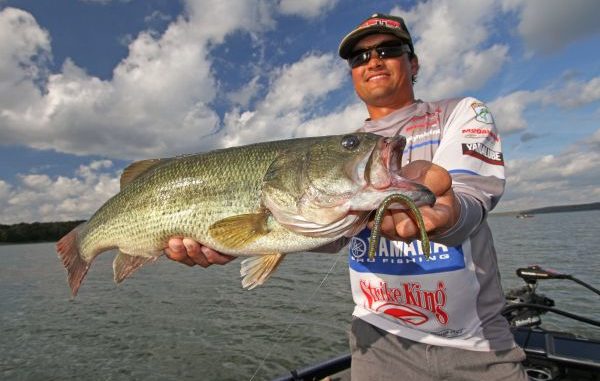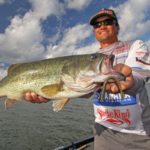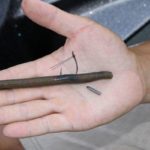
Weightless worms for bass can be deadly effective, but fishing them can be like watching paint dry. But adding a tiny nail weight can allow you to cover more water — and often triggers even more bites.
You’ve heard of “controlled aggression.” Well, you can call this aggressive finesse.
Nail-weighting — inserting a small lead spike into a soft-plastic bait — allows anglers to sink a light worm faster and fish it with more control than your typical subtle presentations.
Bassmaster Elite Series pro Dennis Tietje of Roanoke said this can be a strategic tactic during the transition of late-winter to spring, when we still have some fish suspending in deeper water.
He also noted the value of a nail-weighted worm when prespawn bass start staging around bridge pilings or at the mouths of creeks, canals and other backwater spawning habitat.
Tietje’s fellow Elite pro Kevin Hawk is a big fan of wacky-rigged Senkos, but he’s well aware of the need for patience when presenting this rig near bridge pilings, over deeper drops or any of those prespawn staging areas where waiting on a light bait’s decent is like watching paint dry.
“The most-important advantage that fishing a nail-weighted worm offers me is to be able to fish a wacky-rigged Senko at a fast speed,” Hawk said. “It can take entirely too long for a weightless wacky worm to reach the depth the fish are holding.
“By inserting a nail weight in my worm, it will fall more quickly to the depth the fish are holding, which allows me to cover more water and make more presentations than I could with a weightless Senko. That gives me the opportunity to get more bites.”
As spring unfolds and bass take to the beds, Tietje frequently uses a light nail-weighted worm to taunt the fish into biting. Protective bass would rather shoo away potential nest raiders, but when a bold intruder makes a threatening move, it’s kill time.
“This rig works well when bass are chasing prey away from beds,” Tietje said. “When a fish chases (the nail-weighted worm), you stop it, give it slack and the bait glides backward toward the fish.
“They can’t stand that.”
And the extra weight of the nail makes fishing light tackle efficiently possible.
“This is a good rig for bed fishing because it’s easy to cast on light line,” Tietje said.
And, as Tietje points out, this presentation irritates bedding bass on the front end of the spawn, as well as egg guarders — and later, fry guarders.
It’s not as boisterous as a frog or a small swimbait, but a worm with a lead insert just does a great job of impersonating those persistent bluegill that’ll dash for the stash whenever they see an opening.
There’s more to the tactic than just jamming a bit of nail into a plastic worm, however.
For his wacky-rig presentations, Hawk likes a 5-inch Yamamoto Senko with a 1/0 Owner Weedless wacky hook and a 1/32-ounce nail weight. He’ll increase his nail weight to 1/16-ounce if he wants a faster fall over deeper water.
He also uses a 5 3/4-inch Yamamoto Kut Tail and inserts a 1/16-ounce nail weight into the head.
“If I’m fishing in open water, I’ll use a 1/0 Owner Mosquito Hook or a 1/0 Owner Weedless Wacky Hook around cover,” Hawk said.
But the accomplished finesse specialist said he’ll occasionally reconfigure his nail weighting to vary a traditional bottom-oriented rig.
“If bass are relating to the bottom and they stop biting a conventional Texas-rigged worm, I’ll insert a nail weight into the head of my worm and drag it on the bottom,” Hawk said. “By inserting a nail weight into the head of the worm, it’s going to stand more vertically than a traditional worm Texas-rigged with a bullet weight. It’s also going to have a different action in the water, and will glide more since the weight is embedded in the plastic.
“This presentation will often continue to get you bites when the fish stop hitting a Texas-rigged worm.”
Wataru Iwohori, a Japanese bass pro who has spent some time in under the tutelage of legendary bait designer/FLW Tour pro Gary Yamamoto, foregoes the O-ring common to most wacky presentations.
Instead, he runs his wacky hook, which includes a weed guard, through the worm’s back, parallel to the body, with the point facing aft.
With a truly in-line orientation, Iwohori said he achieves a streamlined presentation that expands the potential of a standard wacky rig.
Think about it: The weight in the worm’s tail helps it “walk” through cover, the back of the hook shank hits any snagging points first and the weed guard enhances the protection.
Tietje agreed.
“It’s easier to work a (finesse worm) through shallow grass with the weight in the tail,” he said.
Basss-fishing legend Gary Dobyns pointed out the instant versatility of a nail-weighted worm — particularly during the transition from winter to spring, when anglers can find bass suspending in deeper water and poking around in the shallows on the same day.
Time of day, as it relates to sunlight and water temperature, is the usual determinant, as bass move shallow or simply rise higher in the water column to find comfortable conditions.
In any case, the ability to quickly switch from a sinking to a slow, fluttering bait and then back again, affords great flexibility.
“When I’m fishing for suspended fish (near the surface), I like to rig Senkos wacky style with no weight,” Dobyns said. “This is what makes the nail-weighted rig so special — you can grab the nail, pull it out and cast for suspended fish on your graph or any working fish you see.
“After the moment has passed, just reinsert the nail weight and continue with a weighted presentation.”






